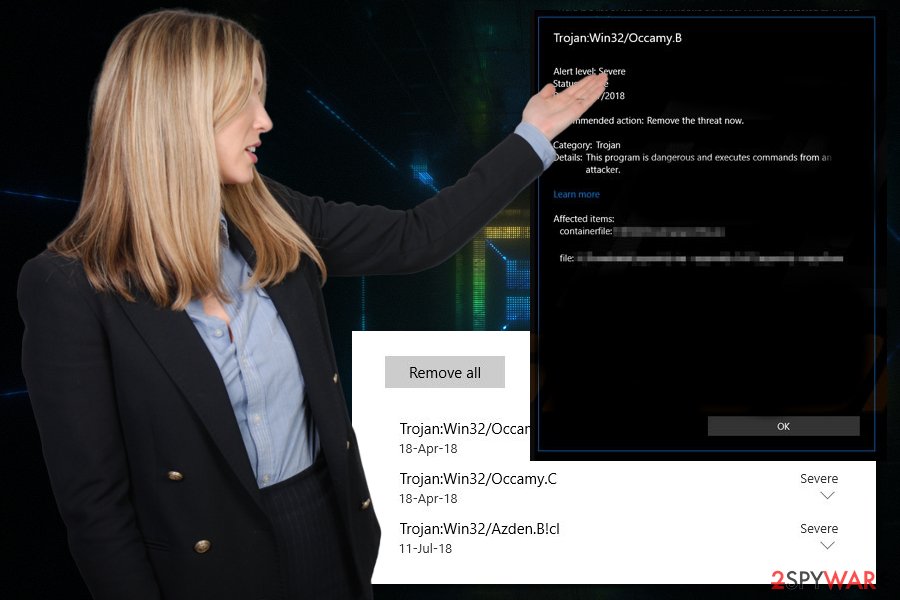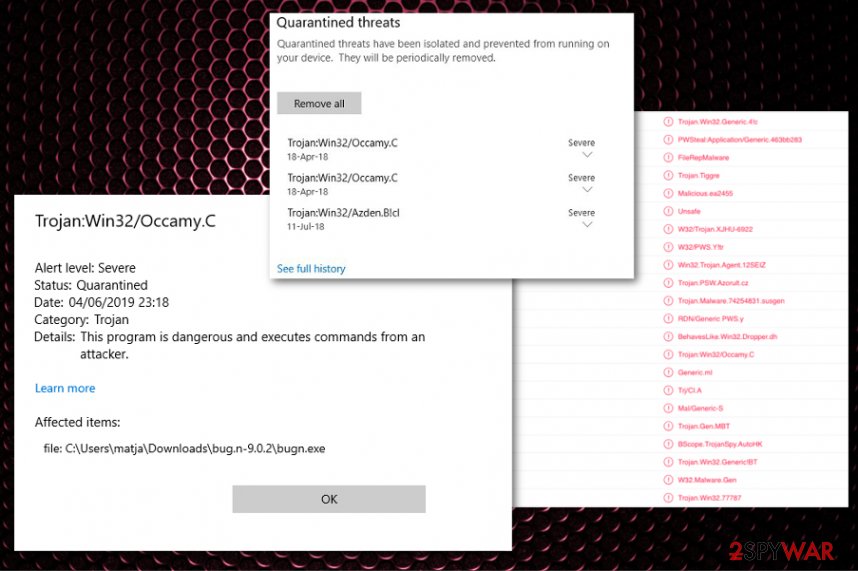Occamy.C (Removal Guide) - Feb 2020 update
Occamy.C Removal Guide
What is Occamy.C?
Trojan:Win32/Occamy.C is the malware that can open backdoors on the infected system for other hackers or load malware

Since Occamy.C trojan drops copies of the malware in various folders, it becomes more difficult to remove. You encounter various system interruptions out of nowhere because of the changes trojan makes. Malware like this can be also used to deliver other malicious programs like ransomware.[1] You need a thorough malware termination so all the additional infections can get completely removed.
| Name | Trojan:Win32/Occamy.C |
|---|---|
| Type | Trojan |
| Purpose | Open backdoors for other malicious actors, install threats, steal information |
| Main danger | Can lead to privacy issues or even identity theft |
| Associated files | nc.exe |
| Associated programs |
|
| Distribution | Spam email attachments, software cracks, infected files |
| Elimination | Install professional anti-malware programs to remove Occamy.C |
This trojan, in particular, can be also called Occamy.C backdoor because it gives remote access to various other threat actors and infiltrates devices with malware like crypto miners or even ransomware. Many antivirus engines can detect this trojan and possibly remove it from the machine.
Trojan:Win32/Occamy.C can be one of the detection names that anti-malware displays after the system scan. However, many different programs have databases of their own, and heuristic names may differ from tool to tool. Make sure to get a reliable tool and scan the system entirely, then follow suggested steps and delete malware from the computer.
Occamy.C virus additionally can cause various issues and errors appearing on the screen:
- 0x00000124;
- 0x000000A4
- 0x000000FA;
- 0x00000054;
- 0x80244030 WU_E_PT_ECP_INIT_FAILED;
- The external cab processor initialization did not complete.;
- 0x80244010 WU_E_PT_EXCEEDED_MAX_SERVER_TRIPS;
- 0x8024001A WU_E_POLICY_NOT_SET A policy value was not set.;
- received an invalid response from the upstream server it accessed in attempting to fulfill the request.
Trojan:Win32/Occamy.C can affect various parts of the machine and since this threat infects Windows devices it even alters DLL files, other files of the system, Widoens registry entries. This is a common method to affect the infected device in general as much as possible so the virus can get launched each time the PC is rebooted.

The virus itself can come to the machine via infected DLL or EXE file which comes from maliciously infected email attachments, software cracks, or other malware that delivers Occamy.C directly on the machine. Trojan also can come via questionable freeware like MI-SUGAR 0.5.8, SoraView 1.0pr4, Functional 1.2, Parnian XTension 3.0, Cribbage Plus! 1.1.6, Small Business Tracker Deluxe 2.0. Make sure to remove these applications, especially if you haven't installed them on purpose yourself.
Occamy.C is also called spyware because it allows attackers to gather data from the system or use different methods to tracks and collect data as banking credentials, logins, and passwords. In most cases, this data gets used for blackmailing purposes or in later scams.[2]
Occamy virus is the umbrella term for various trojans that has the same heuristic name. You may encounter Occamy.C, Occamy.A, or Occamy.B. However, the trojan is a complex malware which has many different purposes that may differ from developer or distributor or even the particular target. Trojan operates in the background silently, so you are not alerted about the presence of the malware.
Occamy.C trojan drops files onto the computer and launches executables or other tasks to send gathered data, download additional files, and accept commands from the remote attacker. Thanks to this fact, you can sometimes notice suspicious processes running in the background when you open the Task Manager.

When you notice two similar processes or even identical EXE files running on the Task Manager, you can try to remove Trojan:Win32/Occamy.C by ending the task. Additionally, experts[3] note that when the suspicious file or process runs causing high usage of CPU and other resources, you can be sure that the process is not legitimate or safe.
Then, you can employ professional anti-malware for Occamy.C removal. Ending the malicious task to disable the virus and get an opportunity to launch your anti-virus is only a first step that allows ending the malicious background process. Additionally, scan the system with reputable anti-virus and finally run FortectIntego to ensure that no corrupted files and similar system changes have been made.
Malicious code hidden in file attachments delivers malware
Sources of trojans can vary as functions of such threats are decided by the developer. However, typical trojan distribution involves spam emails disguised as letters from institutions or services, companies. Emails stating about financial information, receipts, order details or invoices deceive people, and they get tricked into opening such emails with file attachments or hyperlinks.
Once the document attached on the email gets downloaded and opened on the machine or link gets clicked, the malicious script gets either launched on the computer directly or triggers macros and payload carriers that distribute trojans or ransomware.
You can avoid these cyber infiltrations by paying close attention to emails you receive and messages on social media with suspicious links or file attachments. When the email contains a document or executable attached, it should raise your attention, especially when the sender is not a familiar service or company you use at the time.
Delete Trojan:Win32/Occamy.C with malware removal tools like anti-malware
There are many techniques of how such infections come to the system, but you shouldn't forget about the dangerous side of Occamy.C virus infiltration – installation of other malware. Because of this additional payload dropping feature, you need a thorough system scan.
Employing professional anti-malware for Trojan:Win32/Occamy.C removal gives the advantage of cleaning other threats that you were not knowing about because when using the tool like this you can scan the machine entirely and remove all indicated programs or even system issues.
Get SpyHunter 5Combo Cleaner or Malwarebytes to check if they can remove Trojan:Win32/Occamy.C. Remember that there are a few different versions and possibly related viruses that may lure in the system. You may need to enter the Safe Mode before scanning the computer or find a more powerful tool for this task. Finally, checking the system for virus damage is highly recommended.
Getting rid of Occamy.C. Follow these steps
Manual removal using Safe Mode
You should try Safe Mode with Networking before scanning the machine with anti-malware for Occamy.C removal
Important! →
Manual removal guide might be too complicated for regular computer users. It requires advanced IT knowledge to be performed correctly (if vital system files are removed or damaged, it might result in full Windows compromise), and it also might take hours to complete. Therefore, we highly advise using the automatic method provided above instead.
Step 1. Access Safe Mode with Networking
Manual malware removal should be best performed in the Safe Mode environment.
Windows 7 / Vista / XP
- Click Start > Shutdown > Restart > OK.
- When your computer becomes active, start pressing F8 button (if that does not work, try F2, F12, Del, etc. – it all depends on your motherboard model) multiple times until you see the Advanced Boot Options window.
- Select Safe Mode with Networking from the list.

Windows 10 / Windows 8
- Right-click on Start button and select Settings.

- Scroll down to pick Update & Security.

- On the left side of the window, pick Recovery.
- Now scroll down to find Advanced Startup section.
- Click Restart now.

- Select Troubleshoot.

- Go to Advanced options.

- Select Startup Settings.

- Press Restart.
- Now press 5 or click 5) Enable Safe Mode with Networking.

Step 2. Shut down suspicious processes
Windows Task Manager is a useful tool that shows all the processes running in the background. If malware is running a process, you need to shut it down:
- Press Ctrl + Shift + Esc on your keyboard to open Windows Task Manager.
- Click on More details.

- Scroll down to Background processes section, and look for anything suspicious.
- Right-click and select Open file location.

- Go back to the process, right-click and pick End Task.

- Delete the contents of the malicious folder.
Step 3. Check program Startup
- Press Ctrl + Shift + Esc on your keyboard to open Windows Task Manager.
- Go to Startup tab.
- Right-click on the suspicious program and pick Disable.

Step 4. Delete virus files
Malware-related files can be found in various places within your computer. Here are instructions that could help you find them:
- Type in Disk Cleanup in Windows search and press Enter.

- Select the drive you want to clean (C: is your main drive by default and is likely to be the one that has malicious files in).
- Scroll through the Files to delete list and select the following:
Temporary Internet Files
Downloads
Recycle Bin
Temporary files - Pick Clean up system files.

- You can also look for other malicious files hidden in the following folders (type these entries in Windows Search and press Enter):
%AppData%
%LocalAppData%
%ProgramData%
%WinDir%
After you are finished, reboot the PC in normal mode.
Remove Occamy.C using System Restore
-
Step 1: Reboot your computer to Safe Mode with Command Prompt
Windows 7 / Vista / XP- Click Start → Shutdown → Restart → OK.
- When your computer becomes active, start pressing F8 multiple times until you see the Advanced Boot Options window.
-
Select Command Prompt from the list

Windows 10 / Windows 8- Press the Power button at the Windows login screen. Now press and hold Shift, which is on your keyboard, and click Restart..
- Now select Troubleshoot → Advanced options → Startup Settings and finally press Restart.
-
Once your computer becomes active, select Enable Safe Mode with Command Prompt in Startup Settings window.

-
Step 2: Restore your system files and settings
-
Once the Command Prompt window shows up, enter cd restore and click Enter.

-
Now type rstrui.exe and press Enter again..

-
When a new window shows up, click Next and select your restore point that is prior the infiltration of Occamy.C. After doing that, click Next.


-
Now click Yes to start system restore.

-
Once the Command Prompt window shows up, enter cd restore and click Enter.
Finally, you should always think about the protection of crypto-ransomwares. In order to protect your computer from Occamy.C and other ransomwares, use a reputable anti-spyware, such as FortectIntego, SpyHunter 5Combo Cleaner or Malwarebytes
How to prevent from getting trojans
Protect your privacy – employ a VPN
There are several ways how to make your online time more private – you can access an incognito tab. However, there is no secret that even in this mode, you are tracked for advertising purposes. There is a way to add an extra layer of protection and create a completely anonymous web browsing practice with the help of Private Internet Access VPN. This software reroutes traffic through different servers, thus leaving your IP address and geolocation in disguise. Besides, it is based on a strict no-log policy, meaning that no data will be recorded, leaked, and available for both first and third parties. The combination of a secure web browser and Private Internet Access VPN will let you browse the Internet without a feeling of being spied or targeted by criminals.
No backups? No problem. Use a data recovery tool
If you wonder how data loss can occur, you should not look any further for answers – human errors, malware attacks, hardware failures, power cuts, natural disasters, or even simple negligence. In some cases, lost files are extremely important, and many straight out panic when such an unfortunate course of events happen. Due to this, you should always ensure that you prepare proper data backups on a regular basis.
If you were caught by surprise and did not have any backups to restore your files from, not everything is lost. Data Recovery Pro is one of the leading file recovery solutions you can find on the market – it is likely to restore even lost emails or data located on an external device.
- ^ Danny Palmer. Double trouble: Two-pronged cyber attack infects victims with data-stealing trojan malware and ransomware. ZDNet. Technology news.
- ^ Kacy Zurkus. Stolen data used in ongoing sextortion scam. Inforsecurity. IT security and news.
- ^ Ioys. Ioys. Spyware related news.







